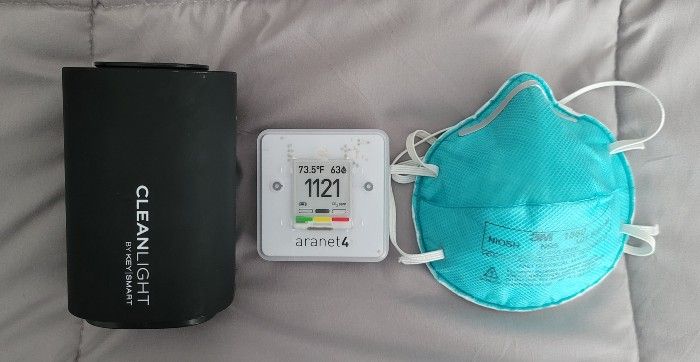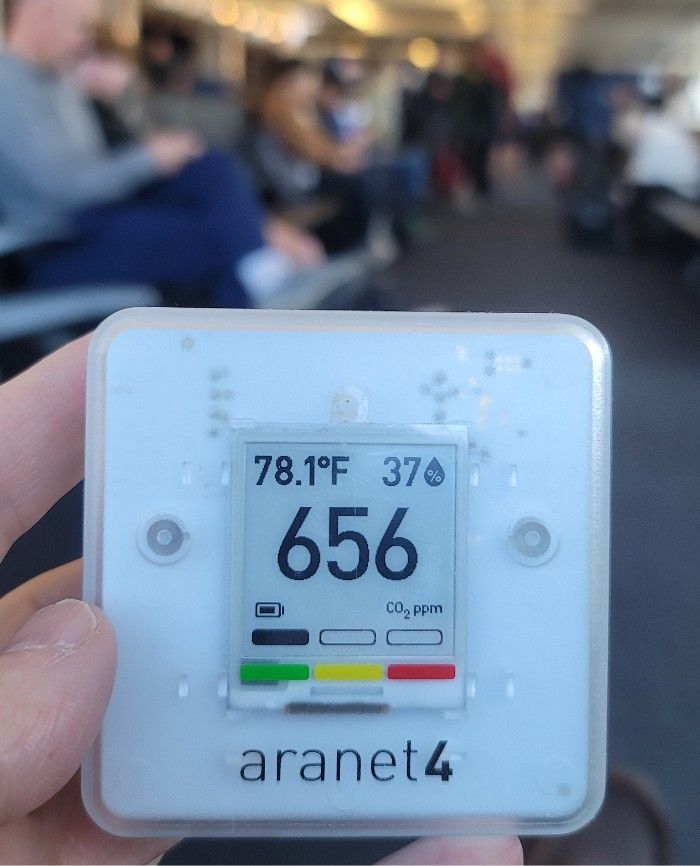A Keynote Speaker's Journey: Strategies to Maximize Respiratory Safety During Air Travel Amid a Pandemic
An immunocompromised keynote speaker, Kevin Kavanagh, MD, shares strategies for safe air travel during the COVID-19 pandemic, emphasizing mask usage, vaccinations, and air quality monitoring, with mixed observations throughout the journey.
Figure 1: From left to right: portable UV-C disinfection air circulation unit, a carbon dioxide monitor, and a N95 mask.
(Photo credit: author)

In October 2023, I was a keynote speaker at a conference in Boston, Massachusetts, necessitating air travel.I used several strategies to maximize my safety. Of course, vaccination and N95 masks were part of them. Let me say on the front end that because of my age and health conditions, I am at high risk for infectious diseases, including COVID-19, influenza, and other respiratory pathogens.
The first step in my travel preparations was to obtain an updated COVID-19 booster plus influenza vaccine 2 weeks before my departure. The durability of the COVID-19 vaccine in the elderly has been a chronic concern, but this way, I should have maximal antibodies. I also brought plenty of N95 masks, a carbon dioxide monitor to avoid sick building syndrome, and a portable UV-C disinfection air circulation unit (Figures 1). Finally, I enrolled in the Transportation Security Administration’s pre-check program to minimize the time I spent in the airport’s security screening area.
I was dismayed that very few, if any, travelers wore masks. There were only 5 people wearing them out of about 200 passengers in the departing waiting area, and almost all were not KN95 or N95 respirators. Surgical and cloth masks (and masks under one’s nose) do not provide the desired level of protection. In addition, one-way masking is not fully protective since one can contract an aerosolized virus through one’s eyes.
The portable carbon dioxide monitor was extremely helpful. During a 2-hour wait for the plane, the carbon dioxide level in the airport seating area rose from above 1100 to just under 1500 ppm as the waiting area filled. Outdoor air has a carbon dioxide level of approximately 420 ppm, and The American Society of Heating, Refrigerating and Air-Conditioning Engineers’s prepandemic recommendation to avoid sick building syndrome was to have levels below 870 ppm. There were also no visible UV-C units in the airport, nor was there an appreciable airflow. Thus, these levels were too high, in fact, some of the highest indoor levels I have recorded indoors. Hence, I kept my mask on and did not take a break to eat. The levels probably rose further, but I then boarded the plane.
I boarded a brand-new Airbus A220-100. According to the airline’s app, it had flown under 1000 miles. Following my research on how best to stay safe, I sat in a row’s window seat since I was around fewer people. In addition, I kept the pressurized air nozzle on, so I was in an air tunnel with the airflow from above my head to the air intake below the seat.
The plane’s carbon dioxide levels were even higher than the airport’s levels, and airflow from the overhead outlet was less than I had experienced in older planes. At one point, the carbon dioxide level reached 2500. It should be noted that a plane’s air is filtered, and the pressure of the air coming out of the nozzle inactivates viruses. However, the lower pressure made me concerned, and the high carbon dioxide level was certainly not ideal for pilot alertness. Allen et al found that there is a 50% decrease in cognition at a CO2 level of 1400 ppm compared to a baseline of 550. Unfortunately, the levels in the plane far exceeded this level. I kept my N95 mask on.
Figure 2: A carbon dioxide monitor showing 656.
(Photo credit: author)

Boston’s Logan Airport’s CO2 level was between 558 and 677 ppm, even in a crowded waiting area. (Figure 2) I wished my departure airport paid equal attention to air quality. If one was going to take their mask off and eat, Boston’s Logan Airport was the place to do so.
Few were wearing masks at Logan Airport, but almost all who wore masks were wearing KN95 and N95 respirators. This had one advantage: I told my Uber driver I would be easy to recognize since I would be the only person wearing a mask.
The Uber ride to the hotel had a carbon dioxide level of 1199 to 2073 ppm. Unhealthy, but probably better than exposure to the city’s smog with the car’s air vent open to the outside air.I was only exposed to 1 person and kept my mask on.However, it is unlikely that a mask would be protective if the driver was shedding viruses into the car's small, enclosed space. Being so close to the driver, projectile spread could also occur, making my portable UV-C filter only partially protective, at best. Thus, I depended upon luck and the booster I received 2 weeks ago.
The hotel room was great. My portable UVC filter came in handy, and the room air’s carbon dioxide level was between 551 and 688 ppm.
While delivering my presentation, I was at least 20 feet away from the nearest participant, but even at that, I still would be susceptible to aerosolized particles. The importance of avoiding large particle projectiles is a reassuring fantasy since smaller aerosolized particles can still infect you and even have a higher viral concentration. I did not wear a mask during my presentation since I wanted all to be able to read my facial expressions and, if hearing impaired, to read my lips. However, this underscores the importance of a layered approach and my recent booster. The carbon dioxide level was in the 900s. This was about 300 ppm higher than I would have liked and possibly represented a 27% increase in circulating airborne pathogens (9% increase for every 100 ppm carbon dioxide increase). Although not ideal, the room’s airflow may have helped mitigate the spread of disease. Again, luck and being boosted aided in my avoiding an infection.
During my presentation, I landed quite a few jokes, which caused laughter and augmented particle aerosolization. This was not a good plan from a public health perspective, but wanting to be accepted (peer pressure) overwhelmed scientific reasoning.
After the presentation, we went out to eat rather late at night at a relatively expensive but not crowded restaurant. We chose a table away from other diners. The carbon dioxide level was between 888 and 951 ppm.
On the return, Logan airport had carbon dioxide levels consistently around 600 (549 to 690), making my wait much safer, but I kept my mask on. There was no downside to doing so. I flew on the exact same plane, and carbon dioxide levels were around 2000 ppm. Again, I stayed masked. When I landed, I hurried out of the airport with the stagnant and probably aerosol-ridden air, and then made it back home. The one thing that was very evident was the United States has a long way to go in providing clean indoor air. But for me, so far, so good, I have not developed a respiratory infection.